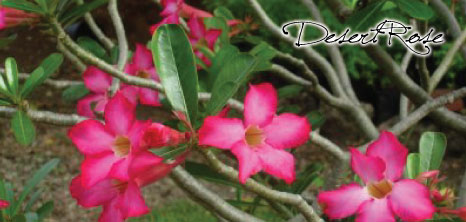|
Desert RoseThe desert rose (Adenium obesum) is an astonishing plant with delicate pink-coloured flowers and bright crimson outer edges that stand out against the plants bulbous stems. It hails from Kenya in East Africa and is a relative of the Frangipani Tree.
Care of the Desert RoseThe desert rose is a high-drainage plant with a distinct, largely swollen trunk that acts as water storage. It should be planted in sandy soil conditions so that there is no water retention and hence limiting chances of root rot. Despite its tolerance to an abundance of rainfall, any standing water or excessive moisture can cause susceptibility to root rot and subsequent death of the plant. In Barbados, the desert rose plant is commonly grown as a house plant due to its need for a consistent temperature. Cloudy or cool weather conditions in Barbados signal a reduction in watering to three to four times a week.
Any occurence of a fleshy or tender area on the desert rose is indicative of root rot and as such, should be removed from the plant immediately and not allowed to spread. The open wound will heal after several weeks and normal growth will resume.
Water requirements of the desert rose should not be confused with root rot. A plant in need of water develops a slight softness in its stem while one that has become inflicted with root rot shows softness in a small area of the stem and gradually spreads to cover a larger area.
The desert rose should be repotted once every two years to stimulate new growth. A pot size increase of approximately 1 to 2 inches is adequate enough to accommodate the additional growth.
Care should be taken not to get the poisonous sap of this plant in contact with children or pets. Should there be such an occurence, the area should be washed with immediate effect.
The desert rose is indeed a tropical beauty on the island of Barbados.
|



